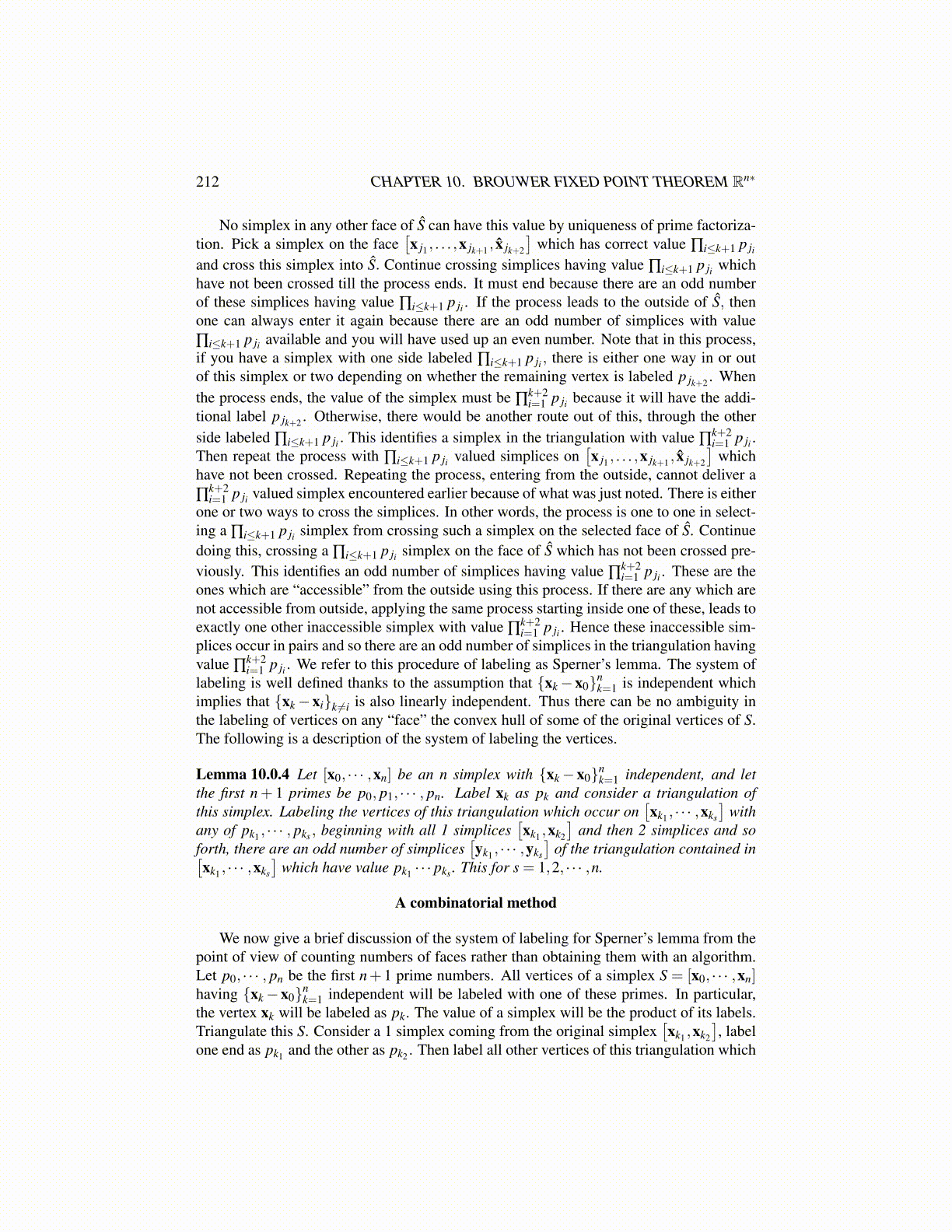
212 CHAPTER 10. BROUWER FIXED POINT THEOREM Rn∗
No simplex in any other face of Ŝ can have this value by uniqueness of prime factoriza-tion. Pick a simplex on the face
[x j1 , . . . ,x jk+1 , x̂ jk+2
]which has correct value ∏i≤k+1 p ji
and cross this simplex into Ŝ. Continue crossing simplices having value ∏i≤k+1 p ji whichhave not been crossed till the process ends. It must end because there are an odd numberof these simplices having value ∏i≤k+1 p ji . If the process leads to the outside of Ŝ, thenone can always enter it again because there are an odd number of simplices with value∏i≤k+1 p ji available and you will have used up an even number. Note that in this process,if you have a simplex with one side labeled ∏i≤k+1 p ji , there is either one way in or outof this simplex or two depending on whether the remaining vertex is labeled p jk+2 . Whenthe process ends, the value of the simplex must be ∏
k+2i=1 p ji because it will have the addi-
tional label p jk+2 . Otherwise, there would be another route out of this, through the otherside labeled ∏i≤k+1 p ji . This identifies a simplex in the triangulation with value ∏
k+2i=1 p ji .
Then repeat the process with ∏i≤k+1 p ji valued simplices on[x j1 , . . . ,x jk+1 , x̂ jk+2
]which
have not been crossed. Repeating the process, entering from the outside, cannot deliver a∏
k+2i=1 p ji valued simplex encountered earlier because of what was just noted. There is either
one or two ways to cross the simplices. In other words, the process is one to one in select-ing a ∏i≤k+1 p ji simplex from crossing such a simplex on the selected face of Ŝ. Continuedoing this, crossing a ∏i≤k+1 p ji simplex on the face of Ŝ which has not been crossed pre-viously. This identifies an odd number of simplices having value ∏
k+2i=1 p ji . These are the
ones which are “accessible” from the outside using this process. If there are any which arenot accessible from outside, applying the same process starting inside one of these, leads toexactly one other inaccessible simplex with value ∏
k+2i=1 p ji . Hence these inaccessible sim-
plices occur in pairs and so there are an odd number of simplices in the triangulation havingvalue ∏
k+2i=1 p ji . We refer to this procedure of labeling as Sperner’s lemma. The system of
labeling is well defined thanks to the assumption that {xk−x0}nk=1 is independent which
implies that {xk−xi}k ̸=i is also linearly independent. Thus there can be no ambiguity inthe labeling of vertices on any “face” the convex hull of some of the original vertices of S.The following is a description of the system of labeling the vertices.
Lemma 10.0.4 Let [x0, · · · ,xn] be an n simplex with {xk−x0}nk=1 independent, and let
the first n+ 1 primes be p0, p1, · · · , pn. Label xk as pk and consider a triangulation ofthis simplex. Labeling the vertices of this triangulation which occur on
[xk1 , · · · ,xks
]with
any of pk1 , · · · , pks , beginning with all 1 simplices[xk1 ,xk2
]and then 2 simplices and so
forth, there are an odd number of simplices[yk1 , · · · ,yks
]of the triangulation contained in[
xk1 , · · · ,xks
]which have value pk1 · · · pks . This for s = 1,2, · · · ,n.
A combinatorial method
We now give a brief discussion of the system of labeling for Sperner’s lemma from thepoint of view of counting numbers of faces rather than obtaining them with an algorithm.Let p0, · · · , pn be the first n+ 1 prime numbers. All vertices of a simplex S = [x0, · · · ,xn]having {xk−x0}n
k=1 independent will be labeled with one of these primes. In particular,the vertex xk will be labeled as pk. The value of a simplex will be the product of its labels.Triangulate this S. Consider a 1 simplex coming from the original simplex
[xk1 ,xk2
], label
one end as pk1 and the other as pk2 . Then label all other vertices of this triangulation which